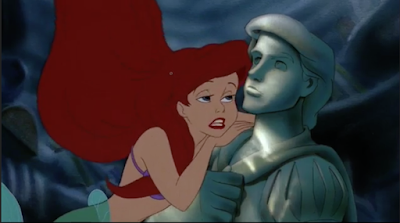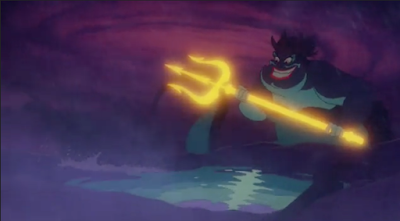The Plot of "The Little Mermaid," As Illustrated by Its Stereotypes
Previously, I explored different stereotypes Disney employs to portray its villains and its heroes. These stereotypes are particularly clear to me in The Little Mermaid, and the stereotypes don't end with Ariel and Ursula.
1.
Already, Eric is being portrayed as strong, handsome, and capable—an undeniable love interest. Look at him tie that rope!
2.
Every Disney father seems to be the same: jolly, large, and lacking some wit.
3.
And here is our heroine: soft-spoken, delicate Ariel who (of course) has that rebellious streak every Disney princess has. Her only redeemable quality seems to be her sense of "adventure", which actually puts her in danger and emphasizes her unintelligence.
Not really a main character, but why are the sharks always the "bad guys" in Disney movies? It ties in to Warner's article that certain animals are associated with villainy while others (like Flounder) are good.
5.
There's always a character in Disney films primarily used for comedy, such as the dimwitted Scuttle.
Evil music, eels (another example of "bad" animals), and green and purple emphasize Ursula's entrance as a villain.
7.
Another note on Ursula's appearance, especially in contrast with Ariel: light vs. dark makeup, narrowed eyes vs. wide eyes, Ursula's stature vs. Ariel's unrealistic body shape, etc. Disney makes it overly obvious in the beginning that Ursula is evil and Ariel is good.
8.
Of course Ariel can sing. Her admirable motives to see more of the world, though, will be squashed as soon as she falls in love and Eric takes over her thoughts. She says "bright young women," yet her portrayal in the movie does not suggest that she's strong and independent.
9.
Every Disney princess has her animal sidekick. Ariel and Flounder are no exception.
Everyone loves Prince Eric, even his dog. How could you not? He's irresistible.
11.
Naturally, it's love at first sight for Ariel. Another cliché, defining Ariel by her romantic choices (as predicted, the rest of the plot revolves around this concept).
12.
Some further "character development" for Eric (if you want to call it that): he's being forced to marry like most other Disney princes, he's strong and fights the storm, and he saves Max and Grimsby. Though Ariel does get some points in this scene for being the one to save the prince (you go, girl!)
13.
Now we're getting into the "real plot": Ariel's hopes and dreams abruptly take a new turn when she falls in love at first sight with someone she can't be with. At least Eric is also set on finding Ariel—it isn't just the girl that falls helplessly in love with the guy.
14.
Our typical villain's monologue, characterized by an evil cackle.
15.
There's always a force that drives against the heroine and tells her to adhere to the norm (see also: "Stick to the Status Quo" in High School Musical). This particular musical number is "Under the Sea."
16.
"Why Eric? Run away with you?" Predictably, Ariel is willing to drop everything for a man she just met. (Side note: In this scene, Ariel also says "You don't know him!" and "Daddy, I love him!" She doesn't know or love him. She just met him!)
When King Triton destroys Ariel's cavern, the colors are red and black—signifying evil. Triton is not a villain, but his motives contradict Ariel's; therefore, in this scene, he is portrayed as bad.
18.
Ursula's wearing a ton of makeup—another indication of villainy.
19.
Lots of sexist parts in this scene. Ariel's wellbeing now relies on her ability to make a man fall in love with her—and she's sacrificing her family and lifestyle to do so.
Secondly, Ursula emphasizes, "You have your looks, your pretty face. And don't underestimate the importance of body language. The men up there don't like a lot of blabber...It's she who holds her tongue who gets a man," implying that men don't like women who speak their minds.
20.
Steam and smoke are also commonly affiliated with villainy. (Also, the scene transitions to green when Ariel loses her voice.)
21.
I just realized Sebastian is a crab because he's always "crabby." Unrelated to the topic, but still worth noting.
22.
All of the maids are "unattractive" women who just stand around and gossip. Pretty stereotypical.
23.
In this scene, Eric is portrayed as the kind, helpful one while Ariel is clueless and uneducated.
24.
The Parisien chef with the moustache who sings in French—another stereotype.
25.
Sebastian's advice to get Eric to kiss Ariel: "You have to look your best. You have to bat your eyes. You have to pucker your lips...like this."
26.
The musical number about the two characters falling in love:
27.
Ariel is awfully eager to give away her whole life to marry a man she just met. It's as if that's her only goal.
28.
Even as a supposedly "beautiful" woman, Ursula still has villain-like features: purple eyes, angular features, dark hair, etc. She's also portrayed as evil in every sense (ex. kicking Max while walking down the aisle).
The water in this scene is red, indicating peril.
30.
A comedic scene with the villain being defeated—these are common in many animated films.
31.
A villain who wants the kingdom—again, a stereotypical motive.
32.
Bloodshot eyes: another trademark of villainy.
33.
There's a scene in every Disney movie where the villain "almost" wins, as if Disney thinks they're tricking the viewer into thinking the hero may not prevail.
34.
Ultimately, the prince saves the princess, just like in every classic fairy tale.
35.
Sebastian and Chef Louis have a typical cat-and-mouse relationship, in which the mouse eventually (comically) defeats the cat.
36.
The father accepts the daughter and the prince and princess live happily ever after, as in every Disney movie. Classic wedding bells sound and a rainbow is cast over the scene.
(Side note: "She really does love him, doesn't she Sebastian?" No, she doesn't. It's still been less than a week.)
This movie is a great illustration of some of Disney's most commonly used stereotypes in its movies. It also goes to show that while Disney relies on tried-and-true characterizations and plot, it doesn't make the film any less lovable.






































Comments
Post a Comment